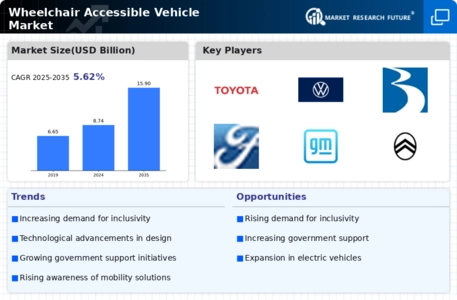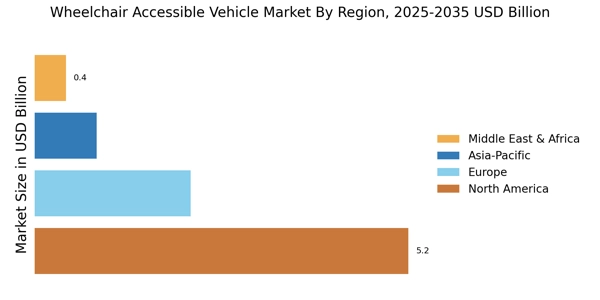Government Initiatives and Funding
Government initiatives aimed at improving accessibility for individuals with disabilities play a crucial role in the Wheelchair Accessible Vehicle Market. Various countries have implemented funding programs and incentives to encourage the purchase of wheelchair accessible vehicles. For instance, tax credits and grants are often available to individuals and organizations that invest in accessible transportation. These initiatives not only alleviate the financial burden on consumers but also stimulate market growth by increasing the number of accessible vehicles on the road. Additionally, regulatory frameworks that mandate accessibility standards for public transportation further bolster the demand for wheelchair accessible vehicles. As governments continue to prioritize inclusivity, the market is likely to experience sustained growth driven by these supportive measures.
Rising Awareness of Disability Rights
The increasing awareness of disability rights is significantly influencing the Wheelchair Accessible Vehicle Market. Advocacy groups and non-profit organizations are actively promoting the rights of individuals with disabilities, leading to heightened public consciousness regarding accessibility issues. This cultural shift is prompting consumers to demand more inclusive transportation options, thereby driving the market for wheelchair accessible vehicles. Additionally, businesses are recognizing the importance of catering to this demographic, leading to partnerships and collaborations aimed at enhancing accessibility in transportation. As societal attitudes continue to evolve, the market is likely to see a surge in demand for vehicles that accommodate the needs of all individuals, regardless of their mobility challenges.
Increasing Demand for Mobility Solutions
The rising demand for mobility solutions among individuals with disabilities is a primary driver of the Wheelchair Accessible Vehicle Market. As awareness of the need for inclusivity grows, more consumers seek vehicles that accommodate wheelchairs. This trend is reflected in the increasing sales of wheelchair accessible vehicles, which have seen a compound annual growth rate of approximately 5% over the past few years. The market is responding to this demand by introducing innovative designs and features that enhance accessibility. Furthermore, the aging population is contributing to this demand, as older adults often require mobility assistance. Consequently, manufacturers are focusing on developing vehicles that not only meet regulatory standards but also provide comfort and ease of use for wheelchair users.
Technological Innovations in Vehicle Design
Technological innovations are transforming the Wheelchair Accessible Vehicle Market by enhancing vehicle design and functionality. Advances in engineering and materials science have led to the development of lighter, more efficient vehicles that are easier to modify for wheelchair access. Features such as automated ramps, advanced securing systems, and user-friendly controls are becoming standard in new models. The integration of smart technology, including mobile applications for vehicle management, is also gaining traction. These innovations not only improve the user experience but also attract a broader customer base, including families and caregivers. As manufacturers continue to invest in research and development, the market is expected to evolve, offering more sophisticated and versatile options for consumers.
Focus on Sustainable Transportation Solutions
The growing emphasis on sustainable transportation solutions is emerging as a key driver in the Wheelchair Accessible Vehicle Market. As environmental concerns become more pressing, consumers are increasingly seeking vehicles that are not only accessible but also eco-friendly. Manufacturers are responding by developing wheelchair accessible vehicles that utilize alternative fuels and energy-efficient technologies. This shift towards sustainability is not only beneficial for the environment but also aligns with the values of a socially conscious consumer base. Furthermore, government regulations aimed at reducing carbon emissions are encouraging manufacturers to innovate in this area. As the market adapts to these changing preferences, the demand for sustainable wheelchair accessible vehicles is expected to rise, presenting new opportunities for growth.


















Leave a Comment